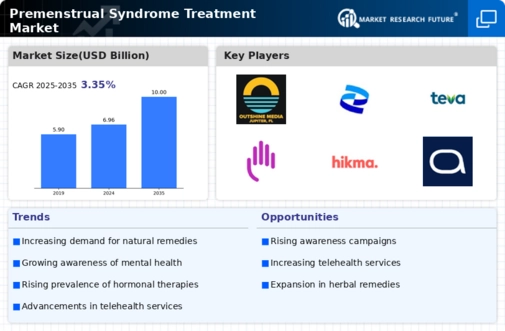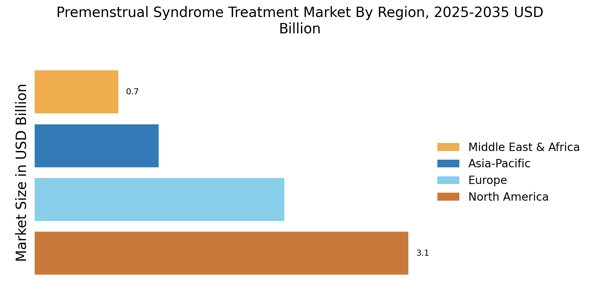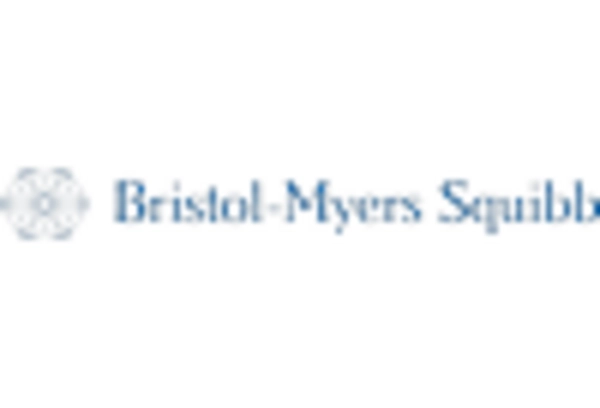Growing Focus on Women's Health
The heightened emphasis on women's health issues is emerging as a pivotal driver for the Premenstrual Syndrome Treatment Market. With a growing number of organizations and advocacy groups dedicated to women's health, there is an increasing push for research, awareness, and treatment options for conditions like PMS. This focus is reflected in the rising number of health campaigns aimed at educating women about PMS and available treatment options. Additionally, the market is witnessing a surge in funding for research initiatives targeting PMS, which could lead to the development of more effective therapies. As societal attitudes shift towards prioritizing women's health, the demand for PMS treatments is expected to rise correspondingly.
Advancements in Treatment Modalities
Innovations in treatment modalities for premenstrual syndrome are likely to play a crucial role in shaping the Premenstrual Syndrome Treatment Market. Recent advancements include the development of novel pharmacological agents, such as selective serotonin reuptake inhibitors (SSRIs) and hormonal therapies, which have shown efficacy in alleviating PMS symptoms. Furthermore, the integration of complementary therapies, such as cognitive behavioral therapy and lifestyle modifications, is gaining traction. The market is projected to witness a compound annual growth rate (CAGR) of around 5% over the next few years, driven by these advancements. As healthcare providers increasingly adopt a multifaceted approach to treatment, the industry is expected to expand, catering to a broader range of patient needs.
Increased Access to Healthcare Services
Enhanced access to healthcare services is likely to significantly influence the Premenstrual Syndrome Treatment Market. The expansion of telemedicine and online health platforms has made it easier for women to seek consultations and treatment for PMS. This accessibility is particularly beneficial for those in remote or underserved areas, where traditional healthcare services may be limited. Furthermore, the implementation of health insurance policies that cover PMS treatments is expected to encourage more women to pursue medical assistance. As healthcare systems continue to evolve and adapt to the needs of patients, the market for PMS treatments is poised for growth, driven by increased accessibility and affordability.
Rising Incidence of Premenstrual Syndrome
The increasing prevalence of premenstrual syndrome (PMS) among women appears to be a significant driver for the Premenstrual Syndrome Treatment Market. Studies indicate that approximately 50 to 80% of menstruating women experience some form of PMS, with a notable percentage suffering from severe symptoms. This rising incidence necessitates effective treatment options, thereby propelling market growth. As awareness of PMS symptoms expands, more women are seeking medical advice and treatment, which further stimulates demand within the industry. The growing recognition of PMS as a legitimate health concern has led to increased research and development efforts aimed at creating innovative therapies, thus enhancing the overall treatment landscape.
Rising Demand for Natural and Alternative Therapies
The growing inclination towards natural and alternative therapies is becoming a notable driver for the Premenstrual Syndrome Treatment Market. Many women are increasingly seeking holistic approaches to manage PMS symptoms, favoring treatments that are perceived as safer and more aligned with their lifestyle choices. This trend is reflected in the rising popularity of herbal supplements, dietary modifications, and mindfulness practices. Market Research Future suggests that the segment for natural remedies is expected to grow at a faster rate compared to traditional pharmaceutical options. As consumers become more health-conscious and informed, the demand for alternative therapies is likely to reshape the treatment landscape for PMS, prompting manufacturers to innovate and diversify their product offerings.


















Leave a Comment